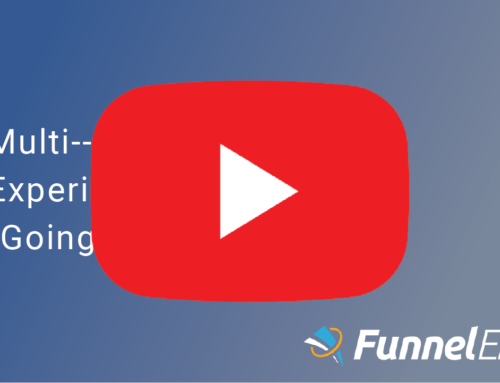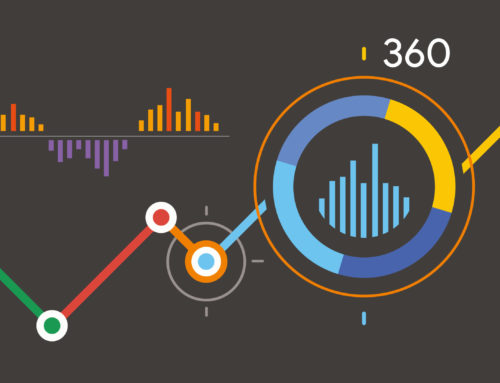When you’re running a SaaS business, it’s easy to feel overwhelmed.
There are mountains of critical issues to deal with. Everything from improving the software and delivering a high quality customer experience, to reducing churn and making payroll every month.
Unfortunately, sometimes these demands drive SaaS businesses to overlook a crucial factor for their success: price.
Drawn out conversations and research is the last thing most people want to do after months (or years) spent developing the software and bringing it to market.
The temptation to just go with a price that feels right—to just “ship it” and see how it goes—is strong. It’s easy to tell yourself you’ll worry about this stuff later—once your business gets off the ground.
But overlooking price in the beginning can set you up for an uphill battle. Here’s how:
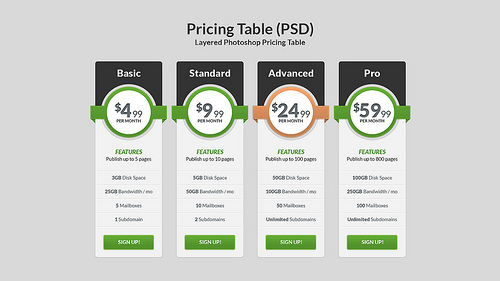
Photo Credit: Sorba Media via Compfight cc
The Dangers of Sub-Optimal Prices
When your price isn’t right, you’re robbing yourself of the opportunity to tap into the full potential of your software business.
You’re already creating value for customers and delivering it to them through your software. But without the right price in place, you’re putting an artificial ceiling on your business’ ability to grow.
The dangers of going with your gut in the beginning—of following intuition instead of analysis—are many. And a lot of people set their prices and forget them. This only compounds the problem because it doesn’t address changes within the niche, evolving customer tastes, or the increasing value of your products.
Even if your intuitive price works in the beginning, that doesn’t mean it will keep working a year or two from now. Business owners who analyze the impact of their price, keep an open mind to change, and make price optimization part of their broader conversion optimization strategy put themselves in a much better position than the “set it and forget it” crowd.
Giving price short shrift puts a lot of pressure to keep new customers coming in the door because you aren’t getting paid the full value of what you’re offering. And churn is a very real threat—especially when people feel like they’re overpaying.
Many SaaS companies don’t have a pricing strategy at all—much less a long-term one.
But it doesn’t have to be that way for you…
A Systematic Approach for Better Prices
Smart pricing helps you maximize your return on investment for every customer you have—even during stagnant periods where new ones aren’t coming in.
Developing a SaaS pricing strategy—and optimizing that strategy over time—allows you to get the most from your business for years to come. It positions you for sustainable success… and an edge over your competitors.
Here’s how to get started:
1. Identify Your Value Metric
The first step to creating a successful SaaS pricing model?
Figuring out exactly what to charge for and how to do it!
A lot of SaaS businesses base their pricing on the number of users who use their software. Customers are forced into higher price tiers as this number increases.
But in most cases, this pricing method (a legacy of the old license purchasing model) is more of a “default option” than the best way to do business.
Why?
Because in most SaaS businesses, the number of users isn’t what the customers value. It’s hard to justify paying a subscription fee—just to get something that isn’t all that important to them. Also, allowing more users access to your software can make customers more likely to stick around because it gets embedded in their organization.
To price better, it’s crucial to identify what about your software matters the most to your customers. Price Intelligently calls this your “value metric.”
Here are just a few potential value metrics:
- Number of reports
- Number of additional sales
- Number of contacts made within the organization
If you don’t know where to start, you can turn to what customers have already told you. Online surveys, feedback, and testimonials are powerful tools to pinpoint what motivates your customers. What are the things people rave about—over and over again? Generate enough feedback and study it, and you’ll notice trends.
Once you find your value metric, base your pricing structure on it—instead of an arbitrary metric that doesn’t matter. This puts you in the best position to convey the full value of what you’re offering and justify higher pricing tiers.
Take a look how FreshBooks, a cloud accounting SaaS, does this on their pricing page:
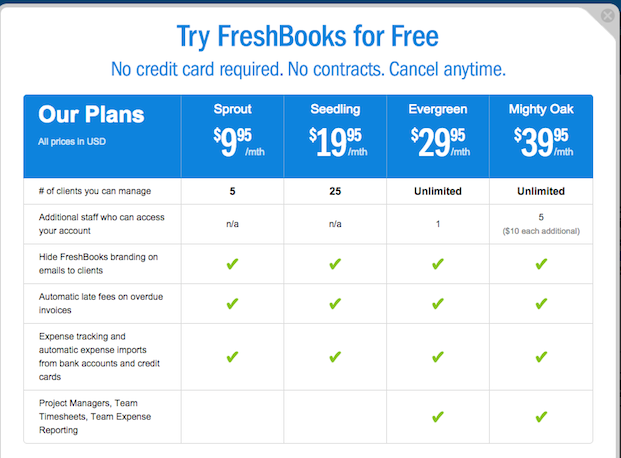
FreshBooks identified their key value metric (the number of clients customers can manage) and made it the primary price differentiator between different paid tiers. Additional staff who can access your account, on the other hand, is a secondary price differentiator.
2. Develop Different Pricing Tiers Based on Customer Personas
How much does your software cost every billing cycle?
Limiting yourself to a single, universal price limits your ability to grow your SaaS business. It throws a big wrench into potential customer’s perceived value of what you have to offer.
Your target customers might share plenty of characteristics, but they’re far from uniform. Different subsets of these people have different needs, sensitivity to price, and reasons for using your product.
Recognizing these subgroups—and developing customer personas to represent them—doesn’t just make your target customers feel special…
It also makes them much more likely to invest in your SaaS business. And for you to be compensated for the full value you deliver.
One company who’s done a fantastic job of developing customer personas for their pricing tiers is Salesforce.com:
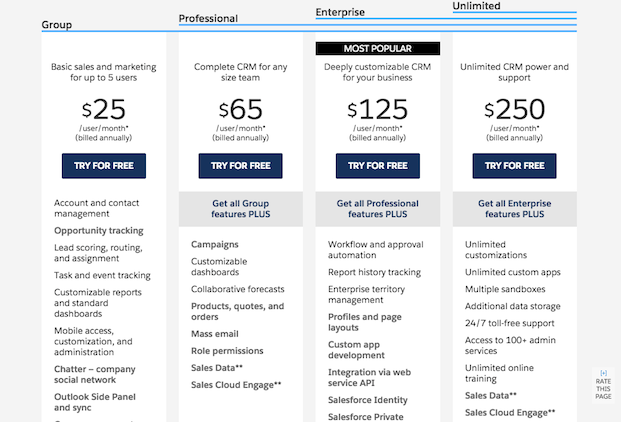
Once you’ve identified “types” of target customers and represented them in personas, you can create different price tiers to cater to each of them.
The goal is to make selecting a price plan as simple and painless as possible. Your price structure acts more like a filter—someone can look at it and know immediately which option fits their unique needs—instead of a source of confusion.
And if you’re worried about target customers not fitting into neat categories, you can always offer a “custom” pricing option to accommodate them.
3. Set Your Prices
Most SaaS businesses skip straight to this step instead of doing any groundwork up front.
But if you’re willing to do that groundwork beforehand, you can make better decisions about how to set and structure your price.
Price Intelligently lays out three excellent guidelines that apply to any value-driven price—regardless of your niche:
- They’re easy for customers to understand
- They’re aligned with what matters most to your customers
- They grow with the extent customers use your software
Let’s take a second to see how a successful SaaS business is applying those guidelines in a real-world example. Here’s a screenshot from the Moz pricing page:
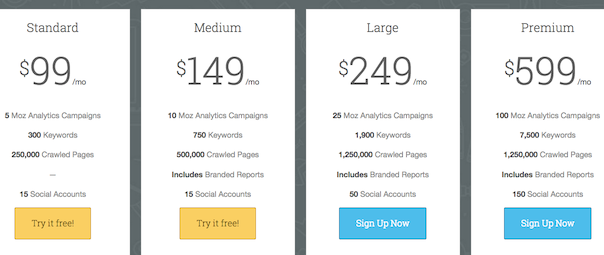
The price tiers are easy to understand (Moz lays out exactly what customers get). They’re also aligned with what motivates customers: analytics campaigns, keywords, crawled pages, etc. And the prices increase with the extent customers use Moz.
It’s easy (and tempting) to jump straight to setting a price without doing any groundwork. But it can be just as easy to get bogged down in research and analysis paralysis. So don’t be afraid to make a decision. Ultimately, there isn’t a “perfect” price. And that’s okay. Take comfort knowing you can (and will) adjust your prices later on.
Another tip to make your pricing more effective: study a bit of pricing psychology and how to use it. Little tweaks here and there can add up to a serious boost in revenue.
4. Display Your Prices on a Captivating Pricing Page
Your pricing page is like a first date. Presentation matters.
This page is the “ultimate attraction” of your website. It’s where practically every potential customer will go before making a buying decision. All of your other website content attempts to drive people onto this page sooner rather than later.
A lot of SaaS businesses do a great job getting visitors to their pricing pages, but the page itself leaves a bad taste in people’s mouth. The slightest whiff of confusion or lack of credibility can cause someone to hesitate and, ultimately, slip through the cracks.
So the dangers of a poor pricing page are real. But so is the opportunity to impress prospects who are on the fence about doing business with you and convincing them to convert.
Above all else, your pricing page should be easy to read and understand. A lot of successful SaaS companies arrange their pricing tiers into a grid so it’s easy for users to compare different options side by side.
Take a look how Box, a file sharing SaaS company, does it:
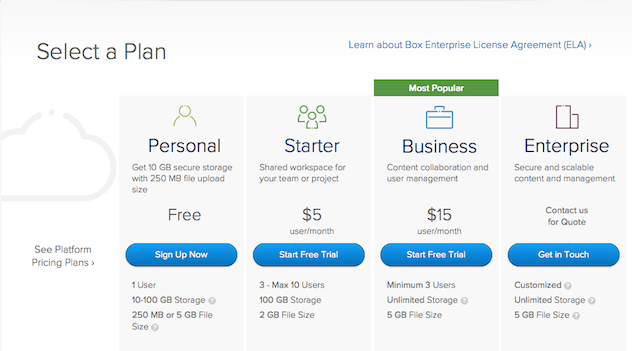
If there are a ton of different features distinguishing your pricing tiers, focus on the most important 5-7. You don’t want to overwhelm people with too many options or visual clutter.
No need for an award-winning web design. Just a little thought delivering a simple, readable page is all it takes to separate you from less attentive competitors. You’ll come off as credible and clear—exactly where you want to be to get the conversion.
5. Continuous Optimization and Tweaking
I saved the most important step for last!
The worst thing you can do about your price isn’t to get it wrong. It’s to get it wrong and not do anything to fix it.
There isn’t a perfect price that will work indefinitely once you lock it in. The market, customer tastes, and your software will constantly change. Maybe a new subset of target customers will emerge (or vanish). But you can use data and analytics to track these changes and make the most of them.
Price is an integral piece in any comprehensive conversion optimization strategy. It’s right up there in importance with your marketing and the product itself.
A commitment to generating feedback on an ongoing basis—and reassessing your pricing strategy every 4 or 6 months based on it—will allow you to tap into the full value of what you’re delivering to customers.
Don’t be afraid to experiment with your pricing. But when you do, pair that experimentation with honest communication about your reasons for making the change. Price changes can be unsettling for some customers, but most are surprisingly understanding—as long as you’re up front with them about your reasons why.
Over to You
It’s easy to get so focused on what you’re selling and how to market it that you overlook how much you’re selling it for.
But price is a crucial part of the equation. You don’t have to get it all figured out right away, but if you’re willing to develop a strategy to optimize your price over time, you set yourself up for long-term success.
Do you have a strategy to improve how you price your software? If so, how have you refined that strategy over time? Leave a comment and share your experience!

